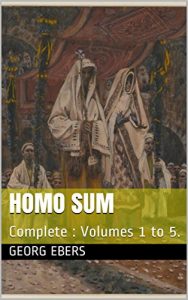Rocks-naked, hard, red-brown rocks all round; not a bush, not a blade,
not a clinging moss such as elsewhere nature has lightly flung on the
rocky surface of the heights, as if a breath of her creative life had
softly touched the barren stone. Nothing but smooth granite, and above
it a sky as bare of cloud as the rocks are of shrubs and herbs.
And yet in every cave of the mountain wall there moves a human life; two
small grey birds too float softly in the pure, light air of the desert
that glows in the noonday sun, and then they vanish behind a range of
cliffs, which shuts in the deep gorge as though it were a wall built by
man.
There it is pleasant enough, for a spring bedews the stony soil and
there, as wherever any moisture touches the desert, aromatic plants
thrive, and umbrageous bushes grow. When Osiris embraced the goddess of
the desert so runs the Egyptian myth he left his green wreath on her
couch.
But at the time and in the sphere where our history moves the old
legends are no longer known or are ignored. We must carry the reader
back to the beginning of the thirtieth year of the fourth century after
the birth of the Saviour, and away to the mountains of Sinai on
whose sacred ground solitary anchorites have for some few years been
dwelling men weary of the world, and vowed to penitence, but as yet
without connection or rule among themselves.
Near the spring in the little ravine of which we have spoken grows
a many-branched feathery palm, but it does not shelter it from the
piercing rays of the sun of those latitudes; it seems only to protect
the roots of the tree itself; still the feathered boughs are strong
enough to support a small thread-bare blue cloth, which projects like a
penthouse, screening the face of a girl who lies dreaming, stretched at
full-length on the glowing stones, while a few yellowish mountain-goats
spring from stone to stone in search of pasture as gaily as though they
found the midday heat pleasant and exhilarating. From time to time the
girl seizes the herdsman’s crook that lies beside her, and calls the
goats with a hissing cry that is audible at a considerable distance.
A young kid comes dancing up to her. Few beasts can give expression to
their feelings of delight; but young goats can.
not a clinging moss such as elsewhere nature has lightly flung on the
rocky surface of the heights, as if a breath of her creative life had
softly touched the barren stone. Nothing but smooth granite, and above
it a sky as bare of cloud as the rocks are of shrubs and herbs.
And yet in every cave of the mountain wall there moves a human life; two
small grey birds too float softly in the pure, light air of the desert
that glows in the noonday sun, and then they vanish behind a range of
cliffs, which shuts in the deep gorge as though it were a wall built by
man.
There it is pleasant enough, for a spring bedews the stony soil and
there, as wherever any moisture touches the desert, aromatic plants
thrive, and umbrageous bushes grow. When Osiris embraced the goddess of
the desert so runs the Egyptian myth he left his green wreath on her
couch.
But at the time and in the sphere where our history moves the old
legends are no longer known or are ignored. We must carry the reader
back to the beginning of the thirtieth year of the fourth century after
the birth of the Saviour, and away to the mountains of Sinai on
whose sacred ground solitary anchorites have for some few years been
dwelling men weary of the world, and vowed to penitence, but as yet
without connection or rule among themselves.
Near the spring in the little ravine of which we have spoken grows
a many-branched feathery palm, but it does not shelter it from the
piercing rays of the sun of those latitudes; it seems only to protect
the roots of the tree itself; still the feathered boughs are strong
enough to support a small thread-bare blue cloth, which projects like a
penthouse, screening the face of a girl who lies dreaming, stretched at
full-length on the glowing stones, while a few yellowish mountain-goats
spring from stone to stone in search of pasture as gaily as though they
found the midday heat pleasant and exhilarating. From time to time the
girl seizes the herdsman’s crook that lies beside her, and calls the
goats with a hissing cry that is audible at a considerable distance.
A young kid comes dancing up to her. Few beasts can give expression to
their feelings of delight; but young goats can.












